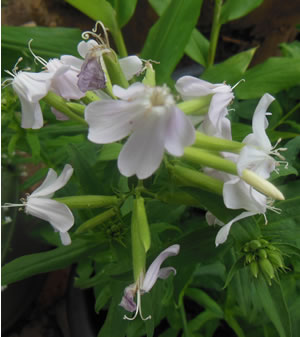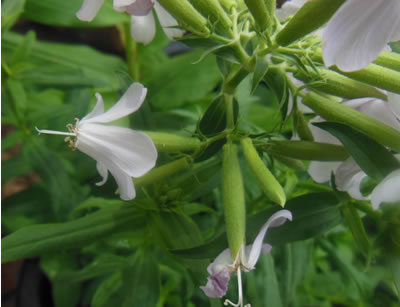Soapwort Saponaria officinalis

Soapwort flowers
- Common Names
- Soapwort , Bouncing Bet, Fuller's herb, Sweet William, Bruisewort, Old Maids Pink
- Botanical Name
- Saponaria officinalis
- Family
- CARYOPHYLLACEAE
Medicinal Uses & Benefits of Soapwort
![]() How to Use|
Side Effects |
Plant & Garden|
How to Use|
Side Effects |
Plant & Garden|
- Medicinal Uses: * Colds
* Eczema
* Gout
* Psoriasis
- Properties: * Anti-inflammatory * Depurative * emetic * Expectorant * Purgative
- Parts Used: Rhizome
- Constituents: saponins
How to Use: Soapwort
The common name of this member of the carnation family indicates it's traditional use in washing; the root produce a lather on contact with water. It has an ancient reputation for treating skin conditions such as psoriasis, eczema, boils, and acne. Taken internally these saponins are a mild irritant to the respiratory and digestive systems making soapwort an expectorant 1and laxative in small doses (see caution). Soapwort's use for gout and rheumatism is probably effective because of the anti-inflammatory and depurative properties of it's saponin content.2
Preparation Methods & Dosage :You can use soapwort root as a simple bath additive by crushing some dried root and putting a few tablespoons in a muslin bag. If you boil the root first to extract the juice, the results will be even better. Soapwort doesn't product much noticeable lather, but gives the bath water a slippery feel, and leaves skin feeling soft and smooth. Soapwort is a great herb to use for skin and hair care and forms the basis of conditioning shampoos and body washes. Can also be taken as a tea.
Soapwort Remedies
Soapwort Side Effects: Soapwort is a strong purgative and mildly poisonous in large doses. Internal use should be guided by a qualified herbalist.
Plant Description

Saponaria officinalis
- Flowers: Pink or whitish, fragrant, about 1 inch broad, loosely clustered at end of stem, also sparingly from axils of upper leaves. Calyx tubular, 5-tooth.ed, about f in. long; 5 petals, the claws inserted in deep tube. Stamens 10, in 2 sets; 1 pistil with 2 styles. Flowers frequently double.
- Stem: 1 to 2 ft. high, erect, stout, sparingly branched, leafy. Leaves: Opposite, acutely oval, 2 to 3 in. long, about 1 in. wide, 3 to 5 ribbed.
- Fruit: An oblong capsule, shorter than calyx, opening at top by 4 short teeth or valves.
- Preferred Habitat: Roadsides, banks, and waste places.
- Distribution: Generally common. Naturalized from Europe
A stout, buxom, exuberantly healthy lassie among flowers is Bouncing Bet, who long ago escaped from gardens whither she was brought from Europe, and ran wild beyond colonial farms to roadsides, along which she has travelled over nearly our entire area. Underground runners and abundant seed soon form thrifty colonies. This plant, to which our grandmothers ascribed healing virtues, makes a cleansing, soap-like lather when its bruised leaves are agitated in water. 1
How to Grow Soapwort
Soapwort prefers well composted soil and excellent drainage. Part sun with some afternoon shade is best. Keep it contained in big pots, or it will spread by underground runners and take over garden space.











